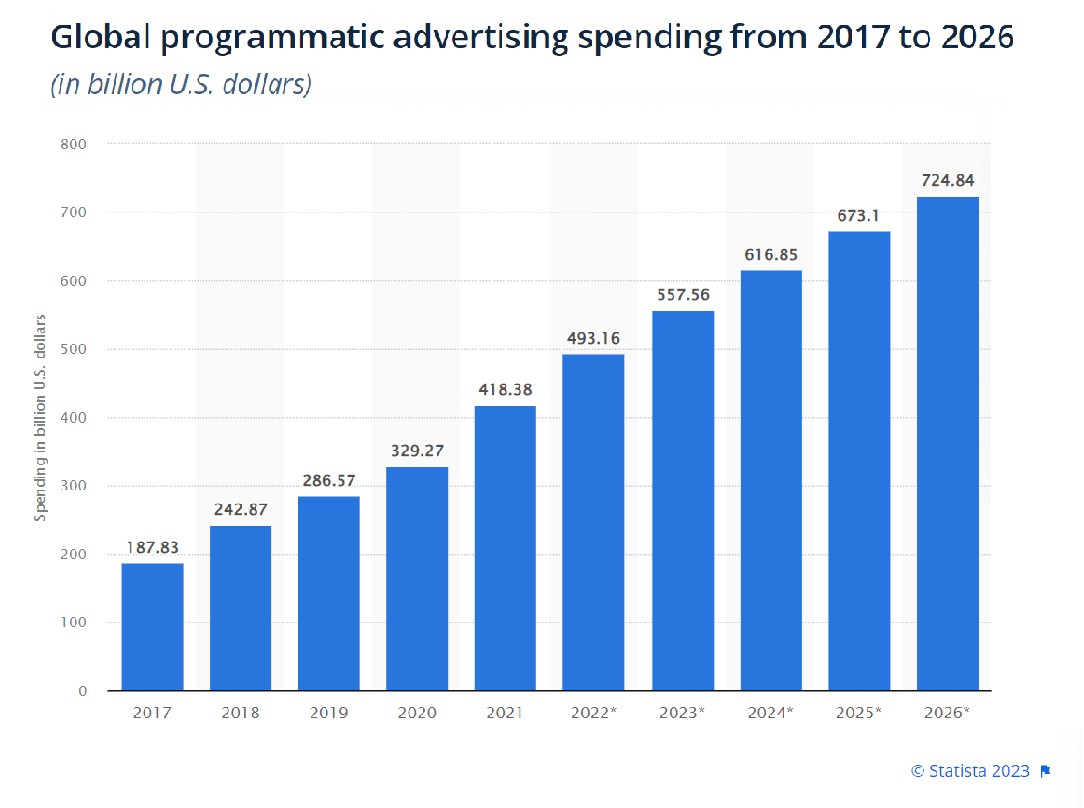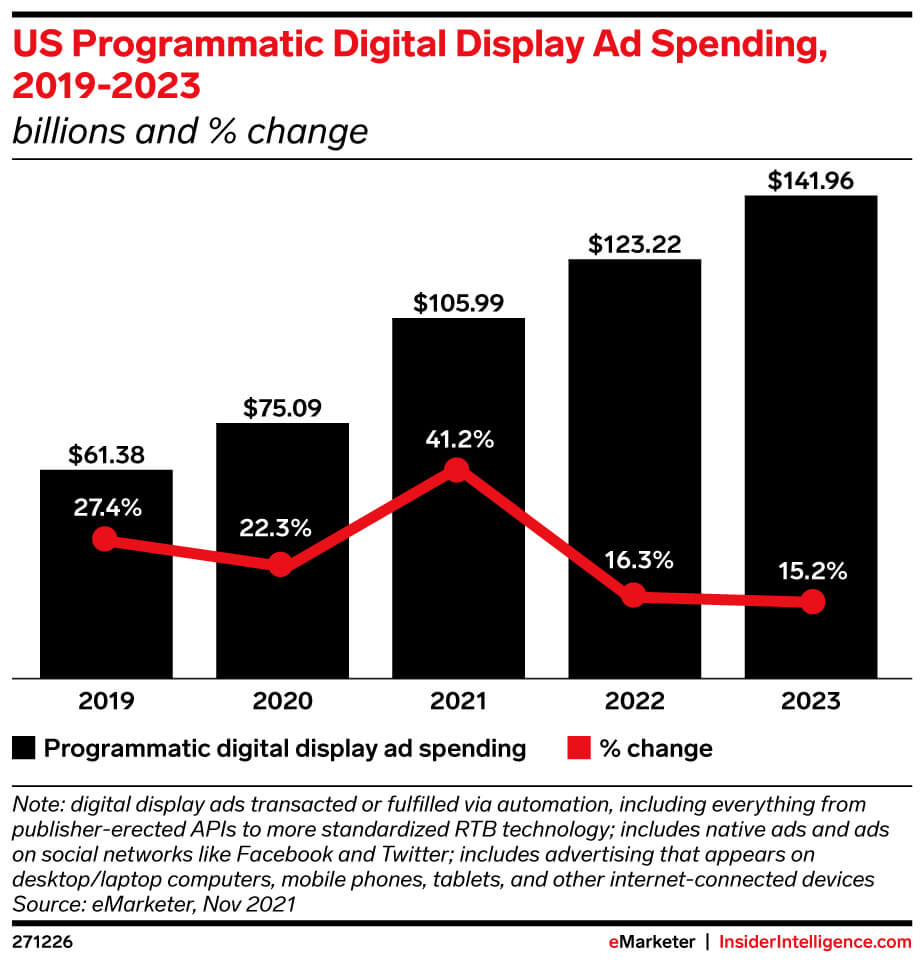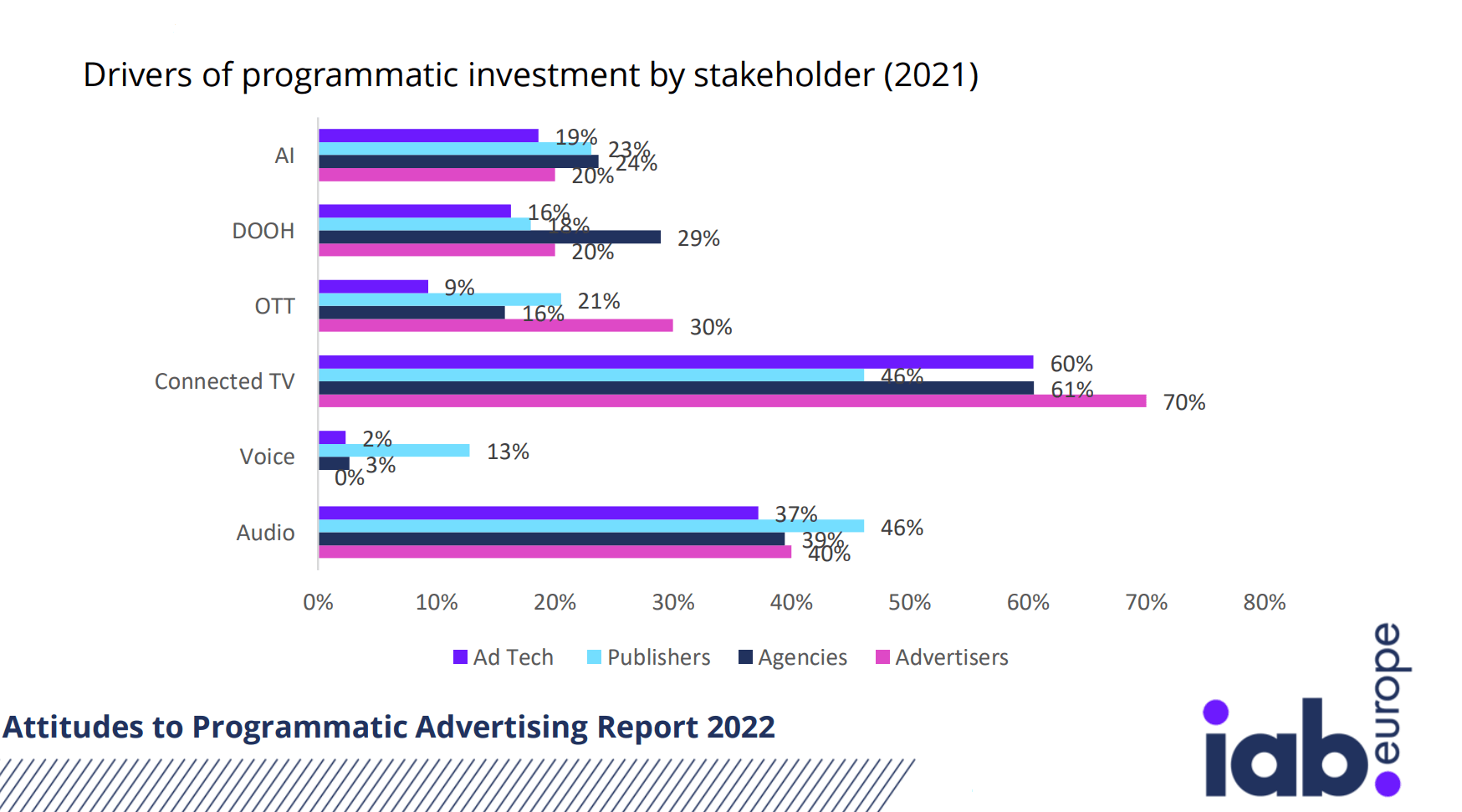Monetization Of Programmatic Advertising
 by Roman Vrublivskyi
by Roman Vrublivskyi
 by Roman Vrublivskyi
by Roman Vrublivskyi
Spoiler alert: you have probably already seen programmatic ads in one way or another, even if this is the first time you’ve seen this word combination. Basically, it’s just a buzzword for a well-known technology (with some useful additions).
According to recent reports, the value of programmatic advertising sold reached an impressive $418 billion in 2021. However, the growth rate is not slowing down, and experts expect this number to grow to $725 billion by 2026. These statistics underscore the tremendous growth and potential of programmatic advertising, reinforcing its position as a dominant force in the advertising industry.

In today’s ever-evolving digital landscape, programmatic advertising has emerged as a powerful tool for marketers and publishers alike. With its ability to automate and streamline ad buying and selling processes, programmatic advertising offers unprecedented opportunities for monetization.
This article delves into the world of programmatic advertising ecosystem, exploring its intricacies and shedding light on the various methods and strategies used to maximize revenue generation. From real-time bidding to data-driven targeting, we uncover the key elements of successful programmatic monetization and delve into the benefits it brings to advertisers, publishers, and the overall digital ecosystem.
Join us as we unravel the dynamic world of programmatic advertising and unlock the potential for monetization in this rapidly evolving landscape.
Programmatic is a way of buying traffic in real time through the interfaces of ad systems, which allows you to focus on purchasing the ‘attention of specific users’ instead of buying ad placements. At the same time, one of the important features of programmatic is the ability to optimize ad campaigns in real time across multiple parameters.
Let’s look at some simple examples.
Example 1: you pay a well-known Instagram blogger for a post promoting your product. This is not programmatic.
Example 2: you use the Google Ads platform to display your banner ads. This is programmatic.
Due to its flexibility, programmatic can be used for various tasks: the ability to buy videos and multiple formats with high standards of visibility and reaching performance (using accurate audience targeting, retargeting, and automatic optimization of campaigns by CPA).

This graph clearly shows that even though the percentages are not increasing fast, the spending on programmatic advertising is growing every year. In this article, we will give you some important tips on getting started with programmatic advertising and making money from it.
Don’t forget to follow these little tips in the new year — your advertising campaigns will please you much more often. Never turn your back on innovation because everything new is the engine of progress and the magnet for a successful future.
Programmatic ad buying is a general term that describes different technologies of algorithmic advertising buying. Therefore, it is better to consider the mechanism of programmatic advertising on concrete examples.
The most famous part of the programmatic is the RTB auction. RTB stands for Real Time Bidding. This technology is used by Google Ads and other well-known advertising systems.
RTB is not synonymous with programmatic but a type of programmatic. In other words, RTB is always programmatic because it is an algorithmic auction. But a programmatic is not always RTB because algorithmic selling of ads is also possible without real-time bidding.
DSP (demand-side platform) is the platform for advertisers that purchases traffic. Creatives and targeting are loaded into its interface, and its algorithm participates in the auction and is responsible for optimizing the campaign.
The main features: targeting specific sites, keywords on pages, devices, geography, browsers, the use of audience segments, remarketing, and the ability to automatically optimize for a given KPI (CPM, CPC, CPV, CPA).
Example: DV360 (DSP from Google), Mediamath, Appnexus, Sizmek.
SSP (supply-side platform) is a system that accumulates traffic from many sites and connects to DSP. In fact, it collects a large network of sites and connects them into a single stream, and allows all of them at once to sell inventory in the auction.
The most famous are Google Ad Manager, Appnexus, Between, Mopub, and Rubicon.
Ad Exchange is an open advertising marketplace that hosts regular auctions of ad inventory. When a space is offered for sale in an RTB auction, the request will be shown to many advertising networks and platforms representing the interests of advertisers.
DMP (data management platform) is responsible for targeting. This system is usually used to collect information about users from various sites and assign them to segments according to different rules. Based on the data from the DMP, the DSP understands which impressions are worth buying for which users.
DMP receives raw data, the sources of which are websites, plugins, social buttons, Internet service providers, etc. The process of collecting and extracting the data is called data mining.
DMP first collects raw data about users’ online behavior. This is anonymized data that contains information about a user’s interests (categories of sites they visit), engagement, devices they use to go online, etc. The task of the DMP is to normalize this data, in other words, segment it and make certain conclusions.
Importantly, RTB guarantees the protection of personal data. DMP knows users not as Jane or John but as id1234567 or id6734509.
The most famous are Bluekai and Lotame.
Main features: purchase of collected segments (e.g., tourists), collection of custom segments for a request (cat owners), collection and storage of own (client) data, collection and storage of data on advertising campaigns (you can show ads to those who clicked on banners from previous campaigns or who finished watching videos till the end).
Programmatic is one of the best tools for monetizing websites or apps. There are two parties involved in this process: the seller and the buyer of the website or blog inventory. To join an algorithmic buy, publishers must sign up for an SSP. Advertisers register on the demand side DSP or ad exchange; after that, they can participate in automated media trading. There are several programmatic monetization strategies, and now we’ll tell you how to monetize programmatic advertising.
Among programmatic ad pricing models, CPM is the most popular and frequently used.
Monetization in advertising typically operates on a pay-per-thousand-view model. Cost per mile means that an advertiser pays for 1,000 ad impressions on different sites (depending on audience segmentation).
Pricing per thousand impressions can be very convenient for advertisers because they pay strictly per impressions performed (regardless of how many clicks they generate). With this model, advertisers with good ad offer win because the impressions collect a lot of clicks, and the price remains the same regardless of the outcome of the campaign.
How does advertising work on a website? How does the software algorithm decide where to place ads? What do AI and ML take into account when deciding which ads to place and where to place them?
The main criterion is targeting. Let’s say a user visits a page on your site. If the characteristics of the visitor who opens your site meet the targeting criteria of the advertising campaign (set by the advertiser on the DSP), the DSP will bid on it, an auction will take place, and the ad of the advertiser who offered the highest price will be shown on your site.
When the ad is shown on your site, and the visitor sees it, you get a certain payment automatically transferred to your SSP. The next time someone else (a user with different characteristics) comes to your site, a new auction starts for that visitor. The auction will be won by the brand that is most interested in showing ads to that user.
To bid, win, and pay for impressions, advertisers must submit their campaign budgets to the DSP. However, for publishers, monetizing a website on the SSP is free (commission is based only on ad revenue generated from ad impressions). All you have to do as a publisher is meet the platform’s criteria for traffic, register your inventory with the SSP, and start earning.
If you are interested in programmatic advertising, you may be wondering what formats and types of ads are supported. The correct answer is — practically all. Nearly every type of advertisement you can think of is supported by programmatic platforms.
This is an advertising format that can be placed on websites as well as in apps. This is one of the most popular types of digital advertising. A banner is a static image placed on any part of the screen, and it does not overlap the main content.
Video advertising in programmatic can be presented as a video banner and video embedded in the player (like ads on YouTube). In addition, videos can be placed on outdoor screens (DOOH advertising). Also, the video format is used in advertising in-game apps (rewarded video).
The main feature of native advertising is that it mimics the appearance of the content of the site or application in which this ad is posted. This format helps combat banner blindness among users; it is less conspicuous and does not spoil the appearance of the resource on which it is placed.
Ads appear in the form of a notification pop-up on the screen. It can be adapted for desktop as well as mobile or tablet versions.
An advertising notification appears on top of the main content of the site or app and blocks access to it until the user closes the ad.
The advertising format is represented by purely audio. These ads are great for radio, podcasts, or music streaming services.
According to the annual study from IAB Europe, the majority of advertisers, publishers, and agencies agree that the most promising area for programmatic advertising is CTV (Connected TV) advertising. CTV advertising is usually presented in video format.
The other advertising formats included in the survey are also in demand and relevant, at least because marketers have identified them as a factor that helps the development of programmatic advertising.

However, before you decide which format you want to work with, first of all, think about your business and your brand. What format is best for your site? What would fit best with your app design? Or, if you’re an advertiser, which format would best represent your product or service?
The decision is worth making, first and foremost, based on your goals and data. What’s also worth mentioning is that more and more companies have recently started investing money into building their own advertising solutions — ad exchanges, SSPs, DSPs, and so on.
Of course, first and foremost, the amount of traffic your resource drives daily has a huge impact. If you are an owner of the entire ad exchange, the ROI will depend on how well you manage the traffic and how wisely you distribute it between your demand partners (DSPs). Plus, there are other factors to keep an eye on:
Although the number of QPS (Queries per second) doesn`t influence your earnings directly, it definitely helps achieve a good profit. QPS is the ability of the platform to send or receive a certain number of requests per second. It can be different depending on the time of day, but the higher this throughput, the better. Also, if your QPS suddenly becomes lower than usual, you can confidently say that there is something wrong with your platform (perhaps some integrations broke).
Metrics are the strongest weapon of all marketers and people who have anything to do with advertising. But they are also the biggest weakness of such specialists. If the metrics suddenly work incorrectly, all their assumptions, strategies, and conclusions can be wrong. For the ad exchange, owner’s metrics can be an important tool for controlling traffic and deals.
This is an algorithmic buying process that allows publishers to provide advertising inventory to advertisers at the same time. It used to be that ad space was offered to advertisers alternately, but with Header Bidding, publishers can provide an equal opportunity to buy ad space to all willing advertisers.
It’s pretty simple. You need to choose the right platform and check what characteristics are required to become a publisher on it. Advertisers also need to make sure they meet eligibility requirements on DSP.
Publishers just need to prove that their site is real and has a large enough number of visitors.
In addition, as a publisher, you can create your own media-buying platform and earn money from media trading between DSPs and SSPs that you integrate there.
However, sometimes it can be expensive to create such a platform from scratch, so there are White Label programs in the programmatic world. In fact, they are the same programmatic platforms, just created not from scratch but using a standard template, and they have many opportunities for customization.
White label is a turnkey advertising exchange platform which has basic tools and settings for running your own marketplace. Read in details how to start working in the programmatic advertising industry and how to build an ad network.
Such a platform can be launched in a week, which is much faster than launching a platform built from scratch. Also, the white label platform can be customized to your brand: the logo and the domain on which it is located can be changed.
An important feature and advantage of white label is that the platform is hosted by the provider, which means you do not have to worry about its hosting and technical maintenance. If you have any technical questions, you can contact your platform provider and get professional advice and assistance.
In addition, when you buy a white label, many vendors provide a personal manager responsible for integrating partners and/or setting up the platform. By the way, SmartHub also has such services.
If you doubt that white label can bring profit to brands, explore the case studies of our clients, to whom white label has greatly helped in developing their businesses.
SmartHub white label ad exchange enables companies of different sizes and budgets to launch their own RTB marketplaces and enter the programmatic market ASAP (up to 7 days). Thanks to the rapid launch, companies can achieve payback and revenue growth much earlier than it is possible with platforms built from scratch. The end-to-end SmartHub white-label technology scales up to various business sizes and adapts to the requirements and budgets of individual enterprises, making it possible for every company to easily enter the programmatic business. Explore our guide about how to get started with programmatic advertising.
Our unique model involves proactive customer care and support from a dedicated team of experts who go the extra mile to ensure exceptional business outcomes. With attentive support, expert guidance, and cost-cutting innovative technology, SmartHub delivers a powerful combination that propels your business towards spectacular results.
Explore the case studies of SmartHub with detailed description of our partners` programmatic business journey and impressive results.
Programmatic can seem complex and confusing at first sight, but behind all the complexities and confusion, there are new opportunities for development. Therefore you should not dismiss the possibilities that programmatic offers just because it may seem difficult to understand at first.
We hope that this article has given at least some clarity about what programmatic advertising is and how you can earn money with it. With SmartHub, you can always easily create your own safe marketplace to help you achieve your goals. You can take full control of your platform, customize it to your brand’s needs, and create an exclusive network of partners with whom you have complete confidence. We’re always here to help you with that. If you are excited about how to start programmatic advertising and achieve an efficient revenue optimization on your ad exchange platform, you can always get in touch with us.
Want to Learn More?
Want to Learn More?
We'll get back to you very soon.